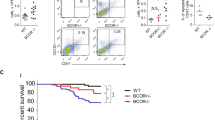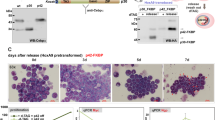Abstract
BCR-ABL oncogene, the molecular hallmark of chronic myelogenous leukemia (CML) arises in a primitive hematopoietic stem cell with both differentiation and self-renewal ability. To study the phenotypic effects of BCR-ABL in a clonal in vitro self-renewal and differentiation model, we have introduced BCR-ABL in the ES cell line CCE. The major effect of BCR-ABL expression was the persistence of primitive morphology of ES cells despite LIF deprivation, correlated with a constitutive activation of STAT3, the major self-renewal factor of ES cells, but no evidence of activation of STAT5. The enforced expression of BCR-ABL in an ES cell line, engineered to express a tetracycline-inducible dominant-negative form of a STAT3, triggered ES cell differentiation with an increased generation of hematopoietic cells expressing erythroid and megakaryocytic phenotypes. RT–PCR analysis for Oct4, Brachyury and β-globin expression confirmed a delay of differentiation in BCR-ABL expressing clones, which could be entirely reversed upon activation of the dominant-negative form of STAT3. To study the possible relevance of STAT3 activation by BCR-ABL in human CML, Western blot analyses performed on the CD34+ cells, purified from CML patients at different stages of their disease, also demonstrated increased levels of STAT3 proteins phosphorylated both on tyrosine and serine residues. These results represent to our knowledge the first functional link between BCR-ABL oncogene and a self-renewal in the context of ES cells through constitutive activation of STAT3. Thus, the BCR-ABL embryonic stem cell model that we developed as well as the results obtained in human CML samples suggests a role for STAT3 in the pathogenesis of human CML.
This is a preview of subscription content, access via your institution
Access options
Subscribe to this journal
Receive 50 print issues and online access
$259.00 per year
only $5.18 per issue
Buy this article
- Purchase on Springer Link
- Instant access to full article PDF
Prices may be subject to local taxes which are calculated during checkout





Similar content being viewed by others
References
Adra CN, Boer PH and McBurney MW . (1987). Gene, 6, 65–74.
Ahmed M, Dusanter-Fourt I, Bernard M, Mayeux P, Hawley RG, Bernardo T, Novault S, Bonnet ML, Gisselbrecht S, Varet B and Turhan A.G . (1998). Oncogens, 16, 489–496.
Audet J, Miller CJ, Rose-John S, Piret JM and Eaves CJ . (2001). Proc. Natl. Acad. Sci. USA, 98, 1757–1762.
Bœuf H, Hauss C, De Graeve F, Baran N and Kedinger C . (1997). J. Cell. Biol., 138, 1207–1217.
Carlesso N, Frank DA and Griffin JD . (1996). J. Exp. Med., 183, 811–820.
Catlett-Falcone R, Landowski TH, Oshiro MM, Turkson J, Levitzki A, Savino R, Ciliberto G, Moscinski L, Fernandez-Luna JL and Nunez G, Dalton WS and Jove R . (1999). Immunity, 10, 105–115.
Clarkson BD, Strife A, Wisniewski D, Lambek C and Carpino N . (1997). Leukemia, 11, 1404–1428.
Daley GQ and Baltimore D . (1988). Proc. Natl. Acad. Sci. USA, 85, 9312–9316.
Daley GQ, Van Etten RA and Baltimore D . (1990). Science, 247, 824–830.
Dugray A, Geay JF, Foudi A, Bonnet ML, Vainchenker W, Wendling F, Louache F and Turhan AG . (2001). Leukemia, 14, 662–670.
Era T and Witte ON . (2000). Proc. Natl. Acad. Sci. USA, 97, 1737–1742.
Ernst M, Novak U, Nicholson SE, Layton JE and Dunn AR . (1999). J. Biol. Chem., 274, 9729–9737.
Gouilleux F, Pallard C, Dusanter-Fourt I, Wakao H, Haldosen LA, Norstedt G, Levy D and Groner B . (1995). EMBO J., 14, 2005–2013.
Grandis JR, Drenning SD, Zeng Q, Watkins SC, Melhem MF, Endo S, Johnson DE, Huang L, He Y and Kim JD . (2000). Proc. Natl. Acad. Sci. USA, 97, 4227–4232.
Groffen J, Stephenson JR, Heisterkamp N, de Klein A, Bartram CR and Grosveld G . (1984). Cell, 36, 93–99.
Holyoake T, Jiang X, Eaves C and Eaves A . (1999). Blood, 94, 2056–2064.
Holyake TL, Jiang X, Jorgensen HG, Graham S, Alcorn MJ, Laird C, Eaves AC and Eaves CJ . (2001). Blood, 97, 720–728.
Horita M, Andreu EJ, Benito A, Arbona C, Sanz C, Benet I, Prosper F and Fernandez-Luna JL . (2000). J. Exp. Med., 191, 977–984.
Huettner CS, Zhang P, Van Etten RA and Tenen DG . (2000). Nat. Genet., 24, 57–60.
Ichiba M, Nakajima K, Yamanaka Y, Kiuchi N and Hirano T . (1998). J. Biol. Chem., 273, 6132–6138.
Ilaria Jr RL and Van Etten RA . (1996). J. Biol. Chem., 271, 31704–31710.
Keller G, Kennedy M, Papayannopoulou T and Wiles MV . (1993). Mol. Cell. Biol., 13, 473–486.
Kennedy M, Firpo M, Choi K, Wall C, Robertson S, Kabrun N and Keller G . (1997). Nature, 386, 488–493.
Konopka JB, Watanabe SM and Witte ON . (1984). Cell, 37, 1035–1042.
Kube D, Holtick U, Vockerodt M, Ahmadi T, Haier B, Behrmann I, Heinrich PC, Diehl V and Tesch H . (2001). Blood, 98, 762–770.
Mui AL, Wakao H, Kinoshita T, Kitamura T and Miyajima A . (1996). EMBO J., 15, 2425–2433.
Nieborowska-Skorska M, Wasik MA, Slupianek A, Salomoni P, Kitamura T, Calabretta B and Skorski T . (1999). J. Exp. Med., 189, 1229–1242.
Niu G, Heller R, Catlett-Falcone R, Coppola D, Jaroszeski M, Dalton W, Jove R and Yu H . (1999). Cancer Res., 15, 5059–5063.
Niwa H, Burdon T, Chambers I and Smith A . (1998). Genes Dev., 12, 2048–2060.
Pear WS, Miller JP, Xu L, Pui JC, Soffer B, Quackenbush RC, Pendergast AM, Bronson R, Aster JC and Scott ML et al. (1998). Blood, 92, 3780–3792.
Pellegrini S and Dusanter-Fourt I . (1997). Eur. J. Biochem., 248, 615–633.
Perlingeiro RCR, Kyba M and Daley GQ . (2001). Development, 128, 4597–4604.
Peters DG, Klucher KM, Perlingeiro RCR, Dessain SK, Koh EY and Daley GQ . (2001). Oncogene, 20, 2636–2646.
Sawyers CL . (1999). N. Engl. J. Med., 340, 1330–1340.
Shtivelman E, Lifshitz B, Gale RP, Roe BA and Canaani E . (1985). Nature (London), 315, 550–554.
Shuai K, Halpern J, ten Hoeve J, Rao X and Sawyers CL . (1996). Oncogene, 13, 247–254.
Sillaber C, Gesbert F, Frank DA, Sattler M and Griffin JD . (2000). Blood, 95, 2118–2125.
Takeda K, Noguchi K, Shi W, Tanaka T, Matsumoto M, Yoshida N, Kishimoto T and Akira S . (1997). Proc. Natl. Acad. Sci. USA, 94, 3801–3804.
Turkson J, Ryan D, Kim JS, Zhang Y, Chen Z, Haura E, Laudano A, Sebti S, Hamilton AD and Jove R . (2001). J. Biol. Chem., 276, 45443–44555.
Zhang X, Blenis J, Li HC, Schindler C and Chen-Kiang S . (1995). Science, 267, 1990–1994.
Acknowledgements
We thank Dr Austin Smith (University of Edinburgh) and ML Wiles for providing GS2 ES cells and CCE cells, respectively, Dr Mc Burnay (University of Ottawa) for the gift of PKJ1 vector, Dr W Pear for the gift of MIGR-p210 BCR-ABL vector and Dr Isabelle Godin for critical reading of the manuscript. This work was supported by grants from the Association pour la Recherche contre le Cancer and Comite de Recherche Clinique de 1'I.G.R. to AGT, and from the Fondation pour la Recherche Medicale and Comite de Recherche Clinique (Institut Gustave Roussy) to PC.
Author information
Authors and Affiliations
Corresponding author
Rights and permissions
About this article
Cite this article
Coppo, P., Dusanter-Fourt, I., Millot, G. et al. Constitutive and specific activation of STAT3 by BCR-ABL in embryonic stem cells. Oncogene 22, 4102–4110 (2003). https://doi.org/10.1038/sj.onc.1206607
Received:
Revised:
Accepted:
Published:
Issue Date:
DOI: https://doi.org/10.1038/sj.onc.1206607
Keywords
This article is cited by
-
STAT3-mediated osteogenesis and osteoclastogenesis in osteoporosis
Cell Communication and Signaling (2022)
-
Tyrosine kinase c-Abl regulates the survival of plasma cells
Scientific Reports (2017)
-
Inhibition of STAT3-interacting protein 1 (STATIP1) promotes STAT3 transcriptional up-regulation and imatinib mesylate resistance in the chronic myeloid leukemia
BMC Cancer (2014)
-
Withacnistin inhibits recruitment of STAT3 and STAT5 to growth factor and cytokine receptors and induces regression of breast tumours
British Journal of Cancer (2014)
-
A pharmacodynamic model of Bcr–Abl signalling in chronic myeloid leukaemia
Cancer Chemotherapy and Pharmacology (2014)



